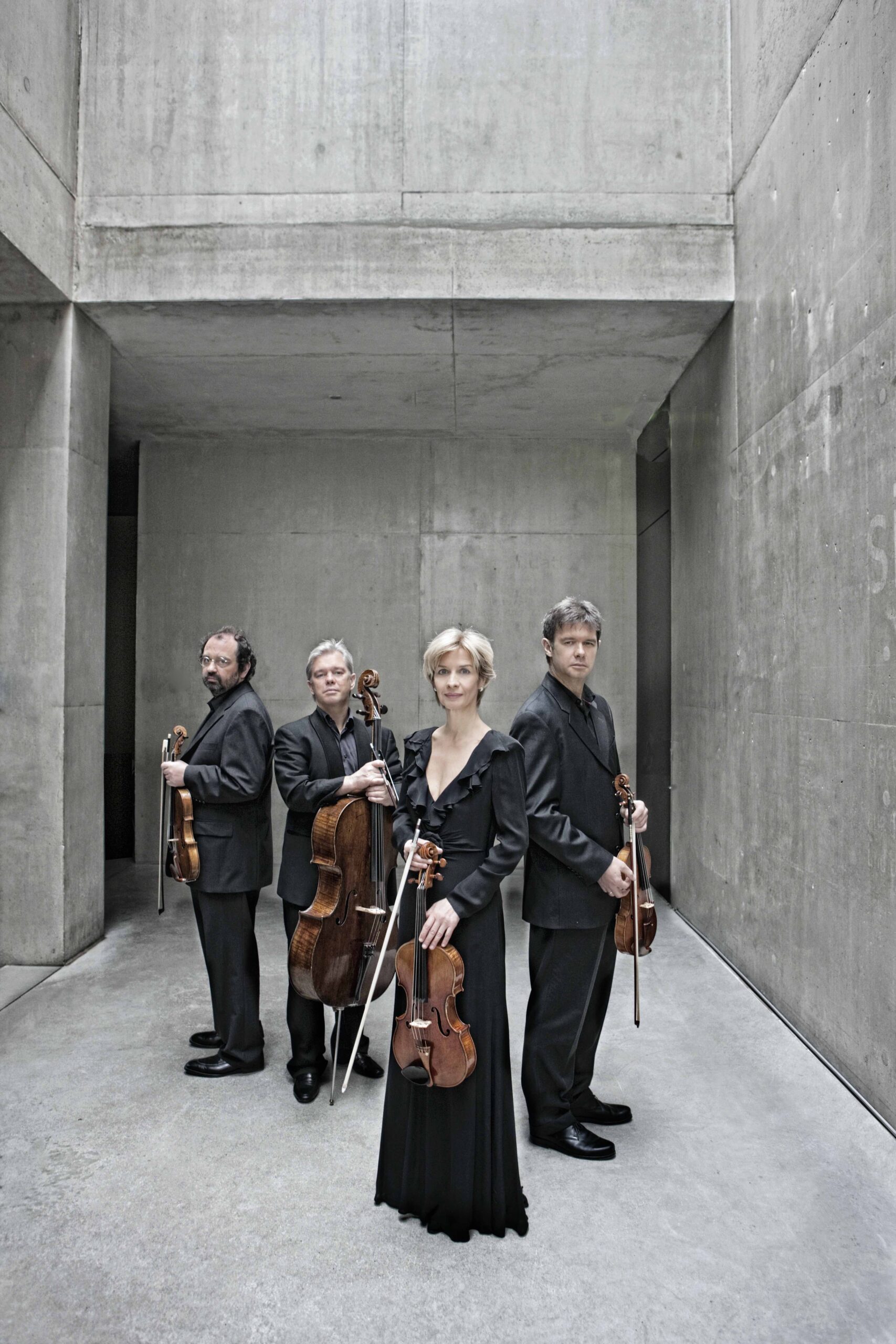By Lucy Caplan
Lucy Caplan is Assistant Professor of Music at Worcester Polytechnic Institute and a winner of the Rubin Prize for Music Criticism.
A palette of emotional intensity unites the three string quartets on this evening’s program. While all three are in minor keys, it would be reductive to describe them simply as sad or troubled. Rather, in their extreme variety, they recall what was known during the Baroque era as the “doctrine of the affections”: the notion that music had the capacity to produce a vast range of responses in its listeners and that specific keys could be associated with particular emotional characteristics. D minor, for example, was melancholy and brooding, whereas C-sharp minor evoked what one theorist called “penitential lamentation.” G minor, by contrast, was thought to be the key of unsettled discontent.
Although Haydn, Beethoven, and Debussy worked long after the years in which this theory was in vogue, their respective quartets offer a compelling demonstration of instrumental music’s capacious emotional range. Haydn’s quartet, Op. 76, No. 2, written late in his career, is both stormy and sophisticated, a striking departure from the levity that characterizes much of his work. Beethoven’s Op. 131, though written just a few decades later, seems to come from another planet entirely: it stretches from earthbound anguish to celestial lightness, insisting on the listener’s rapt attention at every step. Debussy’s quartet is a mélange of beauty and vigor. Composed during a transitional era when late Romanticism was giving way to modernism, it dispenses with the formal conventions of the genre, instead circling around a single unifying theme. In its creative rethinking of what a string quartet can sound like, it foreshadows the upheavals of twentieth-century composition, which would eventually make logics like the “doctrine of the affections” seem quaint, even antiquated.
Joseph Haydn, Quartet in D Minor, Op. 76, No. 2 “Fifths” (c. 1797)
Haydn the jokester—he of the “Surprise” Symphony, with its peaceful melodies interrupted by honking chords, and the “Joke” Quartet, whose last movement disintegrates into a comedy of exaggerated pauses—is nowhere to be found in this quartet. Instead, the piece is characterized by an audacious seriousness. It is written in D minor, a key associated with such monuments as Bach’s Art of the Fugue and Mozart’s Requiem. Its opening four-note theme – one descending fifth, then another – has an arresting simplicity, yet it also catalyzes a display of impressive compositional prowess. Over the course of the first movement, those four notes speed up, stretch out, flip upside down, and morph into larger and smaller intervals. While Haydn’s typical charm remains, this is also a bold reminder that he is a serious composer in every sense of the term.
The second movement is more relaxed. Bearing the unusual tempo marking “Andante o più tosto allegretto,” (indicating that it lies somewhere between the two paces), it is unfailingly elegant. The first theme floats atop a subtle pizzicato accompaniment, which later warms into sustained underlying chords. The first violin takes center stage throughout the movement, which culminates in a cadenza-like passage followed by a rippling close. The minuet that follows has been called the “Witches’ Minuet” due to its mischievous air. A simple figure is presented in canon, with one voice chasing after another; the trio features extreme dynamic contrasts and excursions into the highest part of the first violin’s range. In the fourth movement, Haydn finally offers a hint of his more comical side by way of quick syncopated figures, dramatic pauses, and rustic accompaniments. Yet even this movement has a somewhat restrained affect, never quite lapsing into uncontrolled disorder.
Claude Debussy, Quartet in G Minor, Op. 10 (1893)
The young Debussy was a restless conservatory student, who chafed against the Germanic traditionalism of his teachers. He sought alternative inspiration in creative realms beyond Western art music, from painting to literature to the musical traditions of other cultures (including the Indonesian gamelan, which entranced him when he heard it at the Paris Exposition in 1889). He was especially intrigued by the prospect of leaving form behind, unmooring music from its conventional structures. When it came to the string quartet, he found himself intrigued by the conversational intimacy among players that the genre offered, while also eager to depart from its well established structural norms.
Debussy’s first and only foray into the genre, composed in 1893, stages a tug of war between tradition and the future. The entire piece is governed by a single, forceful theme: presented by all four voices at the outset, it is rhythmically complex, vaguely modal-sounding, and robust in character. But rather than putting this theme through the usual paces, Debussy takes it on a meandering journey. Throughout the first movement, it shares space with a variety of other melodic gestures, recurring at what feel like unpredictable moments. The effect is labyrinthine: we know that we will eventually return to this theme, yet the pathway back is never obvious. The second movement begins with a sped-up, rather frenetic version of the theme played by the viola. It becomes an ostinato, above which the other instruments offer energetic pizzicato commentary (along with a striking, glamorous passage low in the first violin’s range). The third movement is stunningly tranquil. The muted inner voices set the tone, and the theme is cast briefly aside, with all four players wandering about a serene landscape. After a delicate beginning, the fourth movement revs up to offer a fugue-like treatment of the guiding theme. Vivid and vigorous, it builds up to a dramatically drawn-out rendition of the theme before snapping back into a unified texture.
Ludwig van Beethoven, Quartet No. 14 in C-sharp Minor, Op. 131 (1826)
Profound admiration for Beethoven is a constant of Western musical culture. Yet there is a special degree of exaltation reserved for his Quartet Op. 131, which an array of critics and listeners have singled out as his most impressive composition. (Igor Stravinsky called it “perfect, inevitable, inalterable”; Beethoven himself reputedly considered it his best work.) This extraordinary praise might be attributed to the quartet’s remarkable sense of self-contained cohesion: it has a floating-out-of-time quality that seems to locate it outside the typical trajectory of musical evolution. Anything but predictable, it is often likened to a stream of consciousness – yet one that is meticulously crafted, entirely free of clutter or digression.
The quartet is structured in seven linked movements. The first, startingly, is a fugue, based on a slow subject of a wrenchingly somber character. Music for string instruments in C-sharp minor is rare, as the key does not resonate naturally given their tuning, and this only adds to the opening movement’s sense of unease. But in the second movement, Beethoven elevates the quartet to the more resonant key of D major, bringing sunlight in by way of a rustic, elegant dance. The third movement surprises again: recitative-like and ominous, it is extremely brief, yet compresses a diverse array of ideas into barely a minute’s worth of music. The fourth movement, which lies at the work’s core, is an expansive set of variations—a favorite form of Beethoven’s. The opening theme is presented as a conversation among equals, with the two violins trading phrases. The ensuing variations have the feeling of a leisurely tour of a museum: we peer into gallery after gallery, each one full of new types of beauty. After such extended contemplation, the fifth movement, a scherzo, has an intense feeling. While it initially appears straightforward in design, it soon veers off-kilter, as interruptions, pauses, and elongated phrases disrupt its flow. The sixth movement, much like the third, is brief and astonishing: it is a chorale-like adagio, full of introspective anguish. In closing, Beethoven offers a severe, galloping movement that returns to the home key of C-sharp minor. The arpeggiated theme stands its ground, even as moments of relatively serenity attempt to break through. After such overarching intensity, the movement’s abrupt turn to major chords at the very end of the piece comes as a shock. Perhaps this is less a declaration of triumph or satisfaction than it is a reminder of the work’s overall unpredictability—its commitment to taking the path less traveled at every possible turn.






